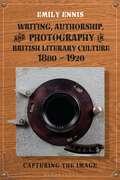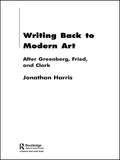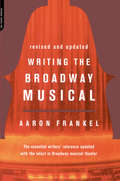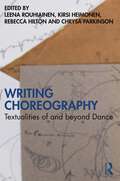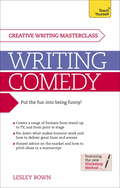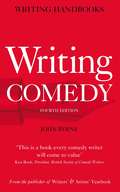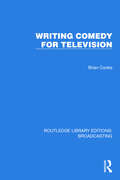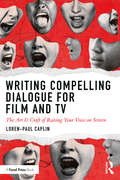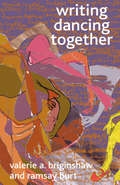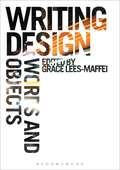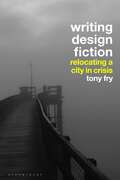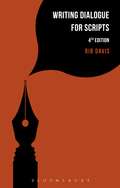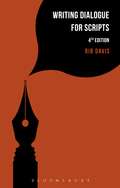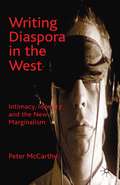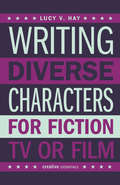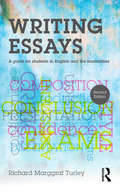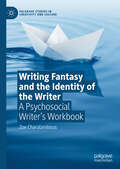- Table View
- List View
Writing, Authorship and Photography in British Literary Culture, 1880 - 1920: Capturing the Image
by Emily EnnisAt the turn of the 20th century, printing and photographic technologies evolved rapidly, leading to the birth of mass media and the rise of the amateur photographer. Demonstrating how this development happened symbiotically with great changes in the shape of British literature, Writing, Authorship and Photography in British Literary Culture, 1880-1920 explores this co-evolution, showing that as both writing and photography became tools of mass dissemination, literary writers were forced to re-evaluate their professional and personal identities. Focusing on four key authors-Thomas Hardy, Bram Stoker, Joseph Conrad and Virginia Woolf-each of which had their own private and professional connections to photographs, this book offers valuable historical contexts for contemporary cultural developments and anxieties. At first establishing the authors' response to developing technologies through their non-fiction, personal correspondences and working drafts, Ennis moves on to examine how their perceptions of photography extend into their major works of fiction: A Laodicean, Dracula, The Secret Agent, The Inheritors and The Voyage Out. Reflecting on the first 'graphic revolution' in a world where text and image are now reproduced digitally and circulated en masse and online, Ennis redirects our attention to when image and text appeared alongside each other for the first time and the crises this sparked for authors: how they would respond to increasingly photographic depictions of everyday life, and in turn, how their writing adapted to a distinctly visual mass media.
Writing Back to Modern Art: After Greenberg, Fried and Clark
by Jonathan HarrisHere for the first time is a full-length study of the 'critical modernisms' of the three leading art writers of the second half of the twentieth century, which helps us build a better understanding of the development of modern art writing and its relation to the 'post-modern' in art and society since the 1970s. Focusing on canonical modern artists such as Manet, Cezanne, Picasso and Pollock, this book provides an important understanding of writing and criticism in modern art for all students and scholars of art theory and art history. Mainstay issues discussed include aesthetic evaluation, subjectivity and meaning in art and art writing. Jonathan Harris examines key discourses and identifies points of significant overlap as well as sharp disjunction between the critics. Developing the notions of 'good' and 'bad' complexity in modernist criticism, Writing Back to Modern Art creates ways for us to think outside of these discourses of value and meaning and helps us to look at the place that art writing holds in the latter twentieth century and beyond.
Writing Back to Modern Art: After Greenberg, Fried and Clark
by Jonathan HarrisHere for the first time is a full-length study of the 'critical modernisms' of the three leading art writers of the second half of the twentieth century, which helps us build a better understanding of the development of modern art writing and its relation to the 'post-modern' in art and society since the 1970s. Focusing on canonical modern artists such as Manet, Cezanne, Picasso and Pollock, this book provides an important understanding of writing and criticism in modern art for all students and scholars of art theory and art history. Mainstay issues discussed include aesthetic evaluation, subjectivity and meaning in art and art writing. Jonathan Harris examines key discourses and identifies points of significant overlap as well as sharp disjunction between the critics. Developing the notions of 'good' and 'bad' complexity in modernist criticism, Writing Back to Modern Art creates ways for us to think outside of these discourses of value and meaning and helps us to look at the place that art writing holds in the latter twentieth century and beyond.
Writing The Broadway Musical
by Aaron FrankelBrimming with advice and techniques, this essential reference for book- and songwriters clearly explains the fundamentals of the three crafts of a musical-book, music, and lyrics. Using copious examples from classic shows, Frankel has created the quintessential musical writers' how-to. Among the topics:definitions of musical theater; differences between musical books and straight plays and between poetry and lyrics; what a score is and how it develops; how to write for the voice; and how to audition musicals for producers. With a new introduction and revised text, Frankel's work is ready to guide a new generation of aspiring writers.
Writing The Broadway Musical
by Aaron FrankelBrimming with advice and techniques, this essential reference for book- and songwriters clearly explains the fundamentals of the three crafts of a musical-book, music, and lyrics. Using copious examples from classic shows, Frankel has created the quintessential musical writers' how-to. Among the topics:definitions of musical theater; differences between musical books and straight plays and between poetry and lyrics; what a score is and how it develops; how to write for the voice; and how to audition musicals for producers. With a new introduction and revised text, Frankel's work is ready to guide a new generation of aspiring writers.
Writing Choreography: Textualities of and beyond Dance
by Leena Rouhiainen Kirsi Heimonen Rebecca Hilton Chrysa ParkinsonA new contribution to studies in choreography, Writing Choreography: Textualities of and beyond Dance focuses upon language and writing-based approaches to choreographing from the perspectives of artists and researchers active in the Nordic and Oceanic contexts.Through the contributions of 15 dance–artists, choreographers, dramaturges, writers, interdisciplinary artists and artist–researchers, the volume highlights diverse textual choreographic processes and outcomes arguing for their relevance to present-day practices of expanded choreography. The anthology introduces some Western trends related to utilizing writing, text and language in choreographic processes. In its focus on art-making processes, it likewise offers insight into how performance can be transcribed into writing, how practices of writing choreograph and how choreography can be a process of writing with. Readers, such as dancers, choreographers, students in higher education of these fields as well as researchers in choreography, gain understanding about different experimental forms of writing forwarded by diverse choreographers and how writing is the motional organisation of images, signs, words and texts. The volume presents a new strand in expanded choreography and acts as inspiration for its continued evolution that engenders new adaptations between language, writing and choreography.Ideal for students, scholars and researchers of choreography and dance studies.
Writing Choreography: Textualities of and beyond Dance
by Leena Rouhiainen Kirsi Heimonen Rebecca Hilton Chrysa ParkinsonA new contribution to studies in choreography, Writing Choreography: Textualities of and beyond Dance focuses upon language and writing-based approaches to choreographing from the perspectives of artists and researchers active in the Nordic and Oceanic contexts.Through the contributions of 15 dance–artists, choreographers, dramaturges, writers, interdisciplinary artists and artist–researchers, the volume highlights diverse textual choreographic processes and outcomes arguing for their relevance to present-day practices of expanded choreography. The anthology introduces some Western trends related to utilizing writing, text and language in choreographic processes. In its focus on art-making processes, it likewise offers insight into how performance can be transcribed into writing, how practices of writing choreograph and how choreography can be a process of writing with. Readers, such as dancers, choreographers, students in higher education of these fields as well as researchers in choreography, gain understanding about different experimental forms of writing forwarded by diverse choreographers and how writing is the motional organisation of images, signs, words and texts. The volume presents a new strand in expanded choreography and acts as inspiration for its continued evolution that engenders new adaptations between language, writing and choreography.Ideal for students, scholars and researchers of choreography and dance studies.
Writing Comedy: How to use funny plots and characters, wordplay and humour in your creative writing
by Lesley BownLearn how to write comedy that makes people laugh.Masterclass: Writing Comedy will reveal to both beginners and experienced writers the distinctive features that mark out comedy from other forms of creative writing. Having identified these, it will help you then to unlock your inner anarchist, and explore the different elements of comedy, using a combination of practical exercises, insight and creative inspiration. Whatever your preferred comic genre, you will find guidance on everything from wordplay and visual humour to plots, comedy characters and different styles.A section on performance will help you to hone stand-up skills, while chapters on stage and screen will give techniques and tips on how to craft a sitcom or create a sketch show. Finally, there is a uniquely frank but useful section on the realities of the markets, and the actualities of going it alone with self-publishing and self-promotion - or the tools you need to successfully pitch an idea or comic manuscript.ABOUT THE SERIESThe Teach Yourself Creative Writing series helps aspiring authors tell their stories. Covering a range of genres from science fiction and romantic novels to illustrated children's books and comedy, this series is packed with advice, exercises, and tips for unlocking creativity and improving your writing. And because we know how daunting the blank page can be, we set up the Just Write online community, at tyjustwrite.com, for budding authors and successful writers to connect and share.
Writing Comedy
by John ByrneComedy has always been one of the most high-profile, glamorous and potentially lucrative markets for scriptwriters, but it is also perceived as one of the hardest. In the fourth edition of this highly regarded handbook, John Byrne breaks down the basics of writing comedy into simple steps and shows you how to make the most of your own comedy writing talent and - just as importantly - your ability to market that talent.Here is a wealth of practical advice both on how to get your career off the ground and how to keep developing it. Whether you are writing comedy routines, sketches or sitcoms, and aiming your work at the page, the stage or the ever-expanding world of broadcasting, you will find something in this book to encourage, inform and inspire you.As with any art form, the basics of good comedy never go out of fashion. While the easy steps in this book are illustrated with examples of work by classic comedians old and new, you will also find useful advice on developing and adapting your work for the twenty-first century market, whether your aim is to promote your work online or simply to keep your gags fresh and topical in a world where the news changes by the minute and gets flashed around the world in seconds.
Writing Comedy (Writing Handbooks Ser. #41)
by John ByrneComedy has always been one of the most high-profile, glamorous and potentially lucrative markets for scriptwriters, but it is also perceived as one of the hardest. In the fourth edition of this highly regarded handbook, John Byrne breaks down the basics of writing comedy into simple steps and shows you how to make the most of your own comedy writing talent and - just as importantly - your ability to market that talent.Here is a wealth of practical advice both on how to get your career off the ground and how to keep developing it. Whether you are writing comedy routines, sketches or sitcoms, and aiming your work at the page, the stage or the ever-expanding world of broadcasting, you will find something in this book to encourage, inform and inspire you.As with any art form, the basics of good comedy never go out of fashion. While the easy steps in this book are illustrated with examples of work by classic comedians old and new, you will also find useful advice on developing and adapting your work for the twenty-first century market, whether your aim is to promote your work online or simply to keep your gags fresh and topical in a world where the news changes by the minute and gets flashed around the world in seconds.
Writing Comedy for Television (Routledge Library Editions: Broadcasting #40)
by Brian CookeWriting Comedy for Television (1983) is a practical, step-by-step manual about how and what to write. It contains many examples from the scripts of various sitcoms and sketch shows. It demonstrates how to construct a storyline for a series, how to lay out a sketch, who to pitch to, and how a television comedy is put together.
Writing Comedy for Television (Routledge Library Editions: Broadcasting #40)
by Brian CookeWriting Comedy for Television (1983) is a practical, step-by-step manual about how and what to write. It contains many examples from the scripts of various sitcoms and sketch shows. It demonstrates how to construct a storyline for a series, how to lay out a sketch, who to pitch to, and how a television comedy is put together.
Writing Compelling Dialogue for Film and TV: The Art & Craft of Raising Your Voice on Screen
by Loren-Paul CaplinWriting Compelling Dialogue for Film and TV is a practical guide that provides you, the screenwriter, with a clear set of exercises, tools, and methods to raise your ability to hear and discern conversation at a more complex level, in turn allowing you to create better, more nuanced, complex and compelling dialogue. The process of understanding dialogue writing begins with increasing writers’ awareness of what they hear. This book provides writers with an assortment of dialogue and language tools, techniques, and exercises and teaches them how to perceive and understand the function, intent and thematic/psychological elements that dialogue can convey about character, tone, and story. Text, subtext, voice, conflict, exposition, rhythm and style are among the many aspects covered. This book reminds us of the sheer joy of great dialogue and will change and enhance the way writers hear, listen to, and write dialogue, and along the way aid the writers’ confidence in their own voice allowing them to become more proficient writers of dialogue. Written by veteran screenwriter, playwright, and screenwriting professor Loren-Paul Caplin, Writing Compelling Dialogue is an invaluable writing tool for any aspiring screenwriter who wants to improve their ability to write dialogue for film and television, as well as students, professionals, and educators.
Writing Compelling Dialogue for Film and TV: The Art & Craft of Raising Your Voice on Screen
by Loren-Paul CaplinWriting Compelling Dialogue for Film and TV is a practical guide that provides you, the screenwriter, with a clear set of exercises, tools, and methods to raise your ability to hear and discern conversation at a more complex level, in turn allowing you to create better, more nuanced, complex and compelling dialogue. The process of understanding dialogue writing begins with increasing writers’ awareness of what they hear. This book provides writers with an assortment of dialogue and language tools, techniques, and exercises and teaches them how to perceive and understand the function, intent and thematic/psychological elements that dialogue can convey about character, tone, and story. Text, subtext, voice, conflict, exposition, rhythm and style are among the many aspects covered. This book reminds us of the sheer joy of great dialogue and will change and enhance the way writers hear, listen to, and write dialogue, and along the way aid the writers’ confidence in their own voice allowing them to become more proficient writers of dialogue. Written by veteran screenwriter, playwright, and screenwriting professor Loren-Paul Caplin, Writing Compelling Dialogue is an invaluable writing tool for any aspiring screenwriter who wants to improve their ability to write dialogue for film and television, as well as students, professionals, and educators.
Writing Dancing Together
by V. Briginshaw Ramsay BurtWith a political agenda foregrounding collaborative practice to promote ethical relations, these individually and joint written essays and interviews discuss dances often with visual art, theatre, film and music, drawing on continental philosophy to explore notions of space, time, identity, sensation, memory and ethics.
Writing Design: Words and Objects
by Grace Lees-MaffeiHow do we learn about the objects that surround us? As well as gathering sensory information by viewing and using objects, we also learn about objects through the written and spoken word - from shop labels to friends' recommendations and from magazines to patents. But, even as design commentators have become increasingly preoccupied with issues of mediation, the intersection of design and language remains under-explored.Writing Design provides a unique examination of what is at stake when we convert the material properties of designed goods into verbal or textual description. Issues discussed include the role of text in informing design consumption, designing with and through language, and the challenges and opportunities raised by design without language. Bringing together a wide range of scholars and practitioners, Writing Design reveals the difficulties, ethics and politics of writing about design.
Writing Design Fiction: Relocating a City in Crisis
by Tony FryWritten by leading design philosopher Tony Fry, Writing Design Fiction: Relocating a City in Crisis is both an introduction to the power of “design fiction” in the design process, and a novella-length work of fiction in itself-telling the dramatic story of the relocation of the City of Harshon.Set in the near future, Harshon, a delta city, is facing environmental catastrophe due to rising sea levels-consequently, a decision is made to relocate the entire city inland. A diverse cast of voices-including an architect, a journalist, an economist, a construction worker, and residents-narrate the extraordinary challenges and complexities which follow. This work presents a real-world scenario which, in coming decades, will face many of the world's cities. The fictional format provides a novel way of exploring the very serious inherent technical, social, political, economic and cultural challenges. The story provides a rehearsal of the design challenges which are likely to face architects, planners, and designers in an uncertain global future.“Design fiction” is a fast-growing area within design and architecture, increasingly deployed as a serious methodology by designers as a tool in scenario planning. Writing Design Fiction takes the practice to a higher level conceptually and theoretically, but also practically. The book is divided into four parts, with the fictional narrative bookended by further critical analysis. Part One shows how a critique of existing modes of design fiction can lead to more grounded and critical thinking and practice. Part Three critically reflects on the narrative, while Part Four presents the practical application of the second order design fiction approach. This book demonstrates the value of a more developed mode of design fiction to students, professional designers and architects across the breadth of design practices, as well as to other disciplines interested in the future of cities.
Writing Design Fiction: Relocating a City in Crisis
by Tony FryWritten by leading design philosopher Tony Fry, Writing Design Fiction: Relocating a City in Crisis is both an introduction to the power of “design fiction” in the design process, and a novella-length work of fiction in itself-telling the dramatic story of the relocation of the City of Harshon.Set in the near future, Harshon, a delta city, is facing environmental catastrophe due to rising sea levels-consequently, a decision is made to relocate the entire city inland. A diverse cast of voices-including an architect, a journalist, an economist, a construction worker, and residents-narrate the extraordinary challenges and complexities which follow. This work presents a real-world scenario which, in coming decades, will face many of the world's cities. The fictional format provides a novel way of exploring the very serious inherent technical, social, political, economic and cultural challenges. The story provides a rehearsal of the design challenges which are likely to face architects, planners, and designers in an uncertain global future.“Design fiction” is a fast-growing area within design and architecture, increasingly deployed as a serious methodology by designers as a tool in scenario planning. Writing Design Fiction takes the practice to a higher level conceptually and theoretically, but also practically. The book is divided into four parts, with the fictional narrative bookended by further critical analysis. Part One shows how a critique of existing modes of design fiction can lead to more grounded and critical thinking and practice. Part Three critically reflects on the narrative, while Part Four presents the practical application of the second order design fiction approach. This book demonstrates the value of a more developed mode of design fiction to students, professional designers and architects across the breadth of design practices, as well as to other disciplines interested in the future of cities.
Writing Dialogue for Scripts (Writing Handbooks)
by Rib DavisA good story can easily be ruined by bad dialogue. Now in its 4th edition, Rib Davis's bestselling Writing Dialogue for Scripts provides expert insight into how dialogue works, what to look out for in everyday speech and how to use dialogue effectively in scripts. Examining practical examples from film, TV, theatre and radio, this book will help aspiring and professional writers alike perfect their skills. The 4th edition of Writing Dialogue for Scripts includes: a look at recent films, such as American Hustle and Blue Jasmine; TV shows such as Mad Men and Peaky Blinders; and the award winning play, Ruined. Extended material on use of narration within scripts (for example in Peep Show) and dialogue in verbatim scripts (Alecky Blythe's London Road) also features.
Writing Dialogue for Scripts (Writing Handbooks)
by Rib DavisA good story can easily be ruined by bad dialogue. Now in its 4th edition, Rib Davis's bestselling Writing Dialogue for Scripts provides expert insight into how dialogue works, what to look out for in everyday speech and how to use dialogue effectively in scripts. Examining practical examples from film, TV, theatre and radio, this book will help aspiring and professional writers alike perfect their skills. The 4th edition of Writing Dialogue for Scripts includes: a look at recent films, such as American Hustle and Blue Jasmine; TV shows such as Mad Men and Peaky Blinders; and the award winning play, Ruined. Extended material on use of narration within scripts (for example in Peep Show) and dialogue in verbatim scripts (Alecky Blythe's London Road) also features.
Writing Diaspora in the West: Intimacy, Identity and the New Marginalism
by P. McCarthyIn this bold intervention into the understanding of the diasporic experience within cultural studies, McCarthy challenges a critical position emergent over the last thirty years (what he calls the 'new marginalism'). He confronts the liberal orthodoxies that prevail in this area, exposing contradictions in the thinking of its major theorists.
Writing Diverse Characters For Fiction, TV or Film: An Essential Guide for Authors and Script Writers
by Lucy V. HayWe're living in a time of unprecedented diversity in produced media content, with more characters appearing who are Black, Asian and Minority Ethnic (BAME), Lesbian, Gay, Bisexual and Transgender (LGBT), disabled, or from other religions or classes. What's more, these characters are increasingly appearing in genre pieces, accessible to the mainstream, instead of being hidden away in so-called 'worthier' pieces, as in the past.How to Write Diverse Characters discusses issues of race, disability, sexuality and transgender people with specific reference to characterisation - not only in movies and TV, but also novel writing.Taking in blockbuster movies such as Mad Max Fury Road, Russell T Davies' ground-breaking TV series Cucumber and and the controversial novel Gone Girl, the book explores:How character role function really worksWhat is the difference between stereotype and archetype? Why 'trope' does not mean what Twitter and Tumblr think it meansHow the burden of casting affects both box office and audience perceptionWhy diversity is not about agendas, buzzwords or being 'politically correct'What authenticity truly means and why research is so importantWhy variety is key in ensuring true diversity in characterisationWriters have to catch up. Knowing not only what makes a 'good' diverse character doesn't always cut it; they need to know what agents, publishers, producers, filmmakers and commissioners are looking for - and why.This book gives writers the tools to create three dimensional, authentic characters ... who just happen to be diverse.'A timely guide to creating original characters and reinvigorating tired storylines' - Debbie Moon, creator and showrunner, Wolfblood (BBC)'Lucy V. Hay nails it' - Stephen Volk, BAFTA-winning screenwriter: Ghostwatch, Afterlife, The Awakening'Packed with practical and inspirational insights'- Karol Griffiths, development consultant and script editor, clients include ITV, BBC, Warner Brothers
Writing Essays: A guide for students in English and the humanities
by Richard Marggraf TurleyEssays are a major form of assessment in higher education today and this is a fact that causes some writers a great deal of anxiety. Fortunately, essay writing is a skill that can be learned, like any other. Through precise explanations, this fully updated edition of Writing Essays gives you the confidence to express yourself coherently and effectively. It demystifies the entire process of essay writing, helping you to become proficient and confident in every aspect. Writing Essays reveals the tricks of the trade, making your student life easier. You’ll learn how to impress tutors by discovering exactly what markers look for when they read your work. Using practical examples selected from real student assignments and tutor feedback, this book covers every aspect of composition, from introductions and conclusions, down to presentation and submission. It also advises you on stress-free methods of revision, helps with exam essays, explains the principles of effective secondary source management, and shows you how to engage meaningfully with other critics’ views. A new chapter will also guide you through the intricacies of the undergraduate dissertation. As a full-time university professor, Richard Marggraf Turley counsels students and assesses their work every day, helping him to recognise the challenges that they face. Accessible, concise and full of practical examples, Writing Essays is a response to these challenges and will be an invaluable companion for Humanities students who wish to improve their grades and become confident in the art of essay writing.
Writing Essays: A guide for students in English and the humanities
by Richard Marggraf TurleyEssays are a major form of assessment in higher education today and this is a fact that causes some writers a great deal of anxiety. Fortunately, essay writing is a skill that can be learned, like any other. Through precise explanations, this fully updated edition of Writing Essays gives you the confidence to express yourself coherently and effectively. It demystifies the entire process of essay writing, helping you to become proficient and confident in every aspect. Writing Essays reveals the tricks of the trade, making your student life easier. You’ll learn how to impress tutors by discovering exactly what markers look for when they read your work. Using practical examples selected from real student assignments and tutor feedback, this book covers every aspect of composition, from introductions and conclusions, down to presentation and submission. It also advises you on stress-free methods of revision, helps with exam essays, explains the principles of effective secondary source management, and shows you how to engage meaningfully with other critics’ views. A new chapter will also guide you through the intricacies of the undergraduate dissertation. As a full-time university professor, Richard Marggraf Turley counsels students and assesses their work every day, helping him to recognise the challenges that they face. Accessible, concise and full of practical examples, Writing Essays is a response to these challenges and will be an invaluable companion for Humanities students who wish to improve their grades and become confident in the art of essay writing.
Writing Fantasy and the Identity of the Writer: A Psychosocial Writer’s Workbook (Palgrave Studies in Creativity and Culture)
by Zoe CharalambousThis book presents the innovative pedagogy of Writing Fantasy: a method for exploring and shifting one’s identity as a writer. The book draws on qualitative research with undergraduate creative writing students and fills a gap in the literature exploring creative writing pedagogy and creative writing exercises. Based on the potential to shift writer identity through creative writing exercises and the common ground that these share with the stance of the Lacanian analyst, the author provides a set of guidelines, exercises and case studies to trace writing fantasy, evidenced in one’s creative writing texts and responses about creative writing. This innovative work offers fresh insights for scholars of creativity, Lacan and psychosocial studies, and a valuable new resource for students and teachers of creative writing.
